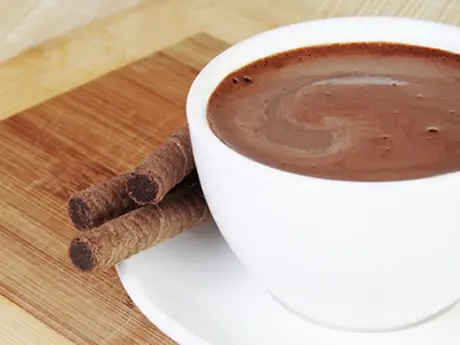
Dark Hot Chocolate
The Why: In most of the country it’s cold—very cold—and drinking hot chocolate makes most of us feel better. In fact, chocolate contains a number of chemicals that affect brain activity. One is tryptophan, the building block of serotonin, which is a relaxation-inducing neurotransmitter that, in large doses (chocolate has small amounts), causes elated or ecstatic feelings.Chocolate also contains anandamide, a substance that stimulates the same brain cell receptors as THC (tetrahydrocannabidinol)—the psychoactive substance in marijuana that induces feelings of euphoria—and phenylethylamine, a brain chemical known to promote feelings of attraction, excitement and giddiness.
Health Perks: One of the key benefits is antioxidants, chemicals that slow down the aging process and help to prevent heart disease and certain kinds of cancer by blocking the cellular and arterial damage caused by oxidation.
Of particular interest is the subclass of antioxidants called flavonoids, which have been proved to keep blood healthy and prevent cell damage and inflammation. A diet supplemented with these antioxidants can slow oxidation of LDL ("bad" cholesterol) and increase the level of HDL (“good" cholesterol).
More: Discover Why HDL Is "Good" and LDL Is "Bad"
In addition, studies show that people who enjoy moderate amounts of dark chocolate—about half a bar per week—have significantly lower blood levels of C-reactive protein, a key marker of inflammation. Flavonoids are also found in green tea, grapes and red wine, but, according to the USDA’s ORAC (Oxygen Radical Absorbance Capacity) database, dark chocolate has the highest antioxidant capacity compared to all fruits and vegetables.
Another heart-healthy chocolate benefit is that it contains stearic acid, a saturated vegetable fat that, when ingested, acts like the monounsaturated fats found in olives and canola oil. Unlike the saturated fat in butter, which may raise cholesterol, monounsaturated fat has a neutral effect, or may even help lower blood cholesterol. So, chocolate raises good cholesterol, lowers bad cholesterol, and its polyphenols can also prevent the DNA damage that may lead to tumor formation.
More: 5 Ways Chocolate Boosts Your Workouts
The downside is that the calories in chocolate can add up, and you can get many of the same benefits from drinking green tea. Another problem is that there aren't any really good ways to tell from the package whether the chocolate you are buying has been tested for its flavonoid content. Look for dark chocolate with a high cocoa content—at least 60 to 70 percent—because that’s where the flavonoids occur.
But cocoa is also quite bitter. It’s the added sugar and fat (including milk and cream) that give chocolate its sweet taste. And keep in mind that if the sources of the cocoa, chocolate liquor or chocolate are modified by the words "alkalized" or "Dutch” or “Dutch processed," it is unlikely to have a significant level of flavonoids. (Milk chocolate uses this process, and benefits are limited). Other things that affect flavonoid content are bean selection, fermentation time and formulation techniques, none of which are indicated anywhere on the package.








0 comments:
Enregistrer un commentaire